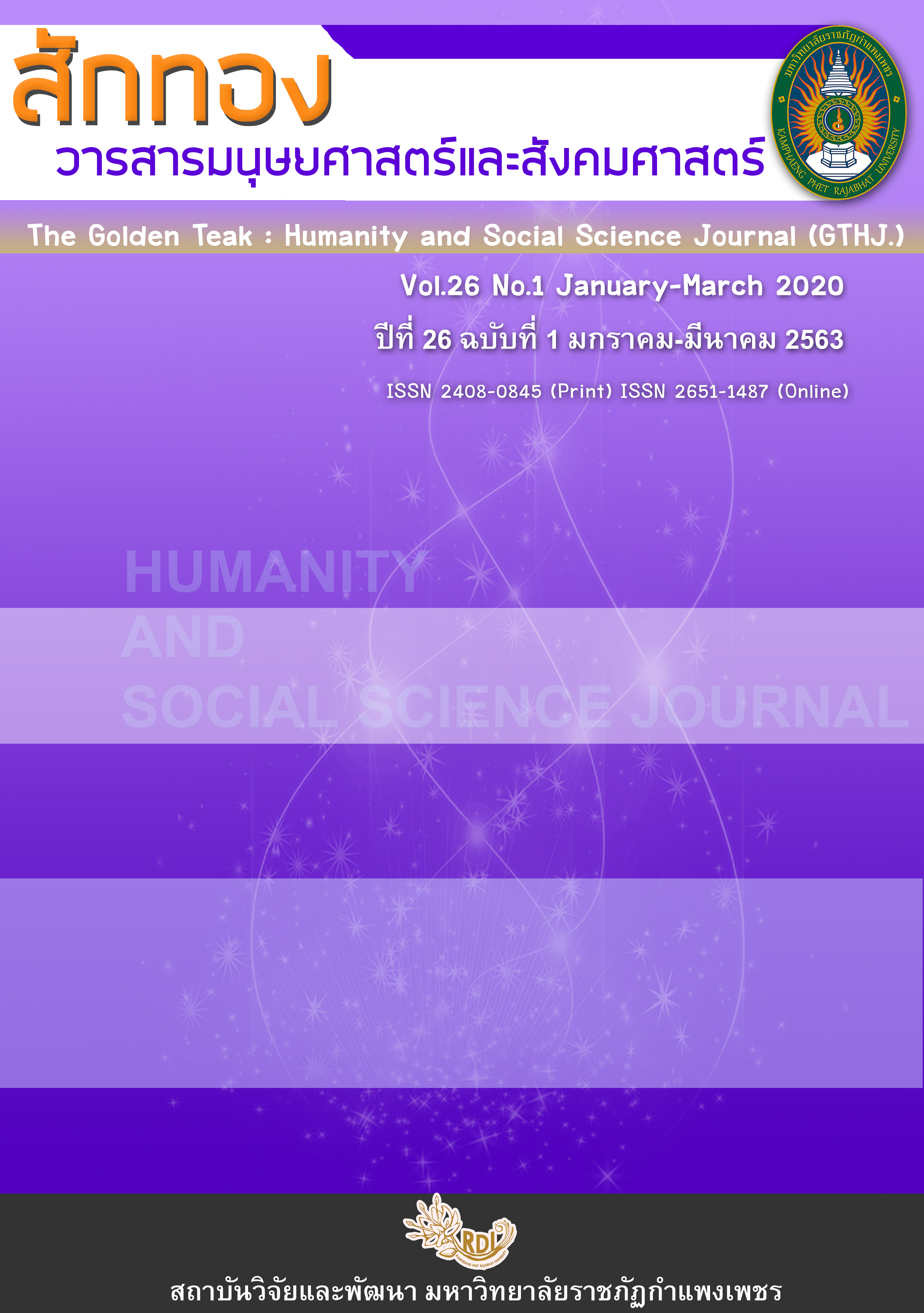The Effects of the STAD Cooperative Learning Technique Using Graded Readers on First-Year English Major Students’ Reading Comprehension and Satisfaction at Rajamangala University of Technology Lanna Tak
Main Article Content
Abstract
This study aimed to investigate the effects of using the STAD cooperative learning with graded readers on first-year English major students’ reading comprehension ability and their satisfaction towards the technique at Rajamangala University of Technology Lanna Tak. Thirty two students of English were assigned to attend three hours of additional reading class once a week for eight weeks. In the study, a reading comprehension test was used as the pre-and posttest and analyzed by t-test to assess the improvement of participants’ reading comprehension ability, and a satisfaction questionnaire was administered to gain the students’ feedback on the STAD strategy. The findings showed that the STAD technique significantly enhance the students’ reading comprehension ability, and the participants were satisfied at a high level to engaging the STAD technique in the reading class.
Article Details
บทความที่ได้รับการตีพิมพ์เป็นลิขสิทธิ์ของวารสาร สักทอง : วารสารมนุษยศาสตร์และสังคมศาสตร์ สถาบันวิจัยและพัฒนา มหาวิทยาลับราชภัฏกำแพงเพชร
ข้อคิดเห็นใดๆ ที่ปรากฎในวารสารเป็นวรรณกรรมของผู้เขียนโดยเฉพาะ ซึ่งมหาวิทยาลัยราชภัฏกำแพงเพชรและบรรณาธิการไม่จำเป็นต้องเห็นด้วย
References
Azmuddin, R.A., et al. (2014). Extensive reading using graded readers. International Journal of Research in Social Sciences, 3(8).
_______. (2014). Extensive reading using graded readers. International Journal of Research in Social Sciences, 3(8), 109-113.
Claridge, G. M.H. (2011). What makes a good graded reader : Engaging with graded readers in the context of extensive reading in L2.
Iwahori, Y. (2008). Developing reading fluency: A study of extensive reading in EFL. Reading in a Foreign Language Vol.20, No.1, pp.70-91.
Jalilifar, A. (2010). The effect of cooperative learning techniques on college students’ reading comprehension. System 38, 96-108.
Johnson, D.W. & Johnson, R.T. (2008). Social interdependence theory and cooperative learning: The teacher's role. In The teacher’s role in implementing cooperative learning in
the classroom (pp.9-37). Springer, Boston, MA.
_______. (2009). An educational psychology success story : Social interdependence theory and cooperative learning. Educational researcher, 38(5), 365-379.
Keuanoon, P & Thadphoothon, J. (2007). Promoting reading comprehension via cooperative reading activities : a classroom investigation. [Online]. Available : jasce.jp/conf05/ Janpha%20paper_nagoya1.doc [2018, August 30].
Khan, S.A. & Ahmad, R.N. (2014). Evaluation of the effectiveness of cooperative learning method versus traditional learning method on the reading comprehension of the students. Journal of Research and Reflections in Education, 8(1), 55-64.
Law, Y.K. (2011). The effects of cooperative learning on enhancing Hong Kong fifth graders' achievement goals, autonomous motivation and reading proficiency. Journal of Research in Reading, 34(4), 402-425.
Long, C. (2015). Implementing Cooperative Learning in Intensive Reading Course for Chinese Learners of English. Sino-US English Teaching, 12(4), 257-264.
Malelohit, J. (2009). The effect of using STAD technique of cooperative learning method on English reading comprehension of the second year students at Thaksin
University, Phathalung Campus. [Online]. Available : www.huso.tsu.ac.th/ huso_mag/.../บทความ%20อ.จุรีภรณ์[1].doc [2018, August 30].
Nejad, S.G. & Keshavarzi, A. (2014). The effect of cooperative learning on reading comprehension and reading anxiety of pre-university students. Journal of Applied
Linguistics and Language Research, 2(8), 169-180.
Pan, C.Y. & Wu, H.Y. (2013). The cooperative learning effects on English reading comprehension and learning motivation of EFL freshmen. English Language Teaching, 6(5), 13.
Roebl, K. (2014). Developing Reading Comprehension Skills in EFL University level Students.
Sharan, S. (1980). Cooperative learning in small groups: Recent methods and effects on achievement, attitudes, and ethnic relations. Review of educational research, 50(2), 241-271.
Slavin, R.E. (1978). Using student team learning. The Johns Hopkins University. pp 21.
_______. (1980). Cooperative learning. Review of educational research, 50(2), 315-342.
_______. (2011). Instruction based on cooperative learning. Handbook of research on learning and instruction, 4.
Todd, R.W. (2006). Why investigate large classes. KMUTT Journal of Language Education, 9, 1-12.
Tran, V.D. (2013). Theoretical Perspectives Underlying the Application of Cooperative Learning in Classrooms. International Journal of Higher Education, 2(4), 101-115.
Warawudhi, R. (2012). English Reading Achievement : Student Teams-Achievement Division (STAD) vs. Lecture Method for EFL Learners. Journal of Institutional Research South East Asia, 10(1).
Wichadee, S. (2005). The effects of cooperative learning on English reading skills and attitudes of the first-year students at Bangkok University. BU Academic Review, 4(2), 22-31.
Wichadee, S. & Orawiwatnakul, W. (2012). Cooperative language learning : Increasing opportunities for learning in teams. Journal of College Teaching & Learning, 9(2), 93.


